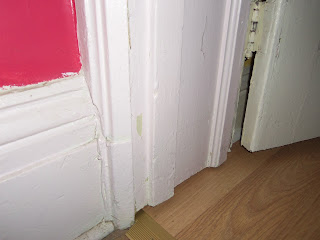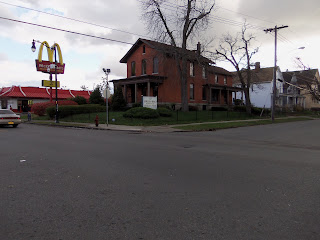This sign hangs above the front door of the Dayton House and it indicates who the house is named for.
This sign is posted at the corner of Amherst and Niagara, at the Western terminus of Amherst St. Black Rock is historic for many reasons and this marks the beginning of the section of the street where the historic district begins.
This sign marks the spot where the British landed prior to their scorch and torch efforts on December 30th 1812. This is one of the most historic spots in the city, but few really know about it.
Down the street from the Dayton House is perhaps one of the most historic and important homes as far as the designation and district goes. The Dayton house boasts ownership by a mayor, but the Howell House was built by a man who was far more important. History shows that he donated one million dollars to the city in order to help establish it. Back in 1830, that was a substantial sum. Can someone please step forward with a similar largess today?
Folks often wonder what historic designation does for a home or area. The Federal and State designation is quite different from local districts and the effect on property values are strongly affected by the type of designation. Federal and State designation is usually the result of an effort to protect an area, neighborhood or structure from demolition or devaluation as the result of an infrastructure project. This was the case with Black Rock. The study was done to protect this part of the city from a project which sought to build an international truck bridge. The effect would have been devastating. The study and designation has ensured a stable future for the neighborhood and we are grateful for it.
Local designations are often sought for neighborhoods that seek to achieve a certain cache and are in need of revitalization. A prime example would be Allentown which is governed by the Allentown Association. There is a strict committee that oversees the development and future improvements for the area and seeks to preserve the physical characteristics and charm of the district. Within the district there are also Federal and State designated properties, but not all buildings in Allentown are designated historic.
The type of designation a structure has affects its over-all property value. It's a complex topic and most research done to quantify the benefits have been done by urban planners and other civic organizations. It is hard to broadly apply the results because each city/town is different.
For Federal and State designated properties, there is extra value because of tax credits available for repairs and improvements that meet the SHPO and Federal guidelines as being done for the good of the house. If the application does not meet standards, the work can still be done -- there is no restriction on style, materials, etc. The issue is with what is considered worthy of receiving the tax credit. Things like a new boiler, roof replacement, and other sort of repairs that keep the house standing.
Local districts face a different standard. Repairs and other enhancements must keep with the character of the district and are subject to a board/committee approval. The owner of a building in a local district faces much stronger standards and obstacles when it comes to working on their property.
Valuation of properties are affected by designations. It is generally recognized that a designation will usually add 15% value to the property. An additional 15% can be considered appropriate if a person of note lived or owned it. This means the person or group needs to be rather famous or have enough notoriety to be recognizable -- or a very important event had to have taken place that is widely known about. An additional 15% can be added of the structure itself is of superior construction, style or quality. On the whole a property does very well if it achieves a valuation of 131% as a result of it's status.
Often Federal/State will help add value because the cost to maintain the property is offset by tax credits and also because there is less cost involved because historically correct/committee certified material isn't required. Homes that must go through a strict approval process can actually suffer because there is an assumption that maintenance will be more onerous. Then again, if the district itself means the house is situated in a superior location because of the district, location can trump that concern.
The location of an historic property can affect its value too. A home that is nearer to a major city or important historic area will generally value higher than one which is remote or further away. A truly horrible/dangerous location might weigh negatively in the analysis of over-all value, but the designation will still probably help the building gain a higher value over other properties in proximity to it.
Finally, the cost to restore a building come into the equation. If it will cost more than 50% of a building's over-all value to bring it up to functional and "restored" standard, that can negatively affect any sort of Cost Valuation done on the property.
This is a very general explanation. Accurate valuation of an historic property can only be done by a highly qualified, certified and registered professional (a CRA is a Certified Residential Appraiser). While it is generally held that an historic property carries a higher value than it's non designated counter-part a true analysis of it's value is not always easy to attain. The major goal in determiningt the worth of any home is the life it will provide. We are after all, living in a "home" and not a share of stock or calculated number.



















































